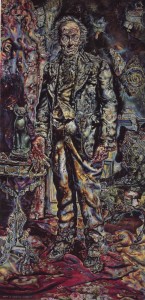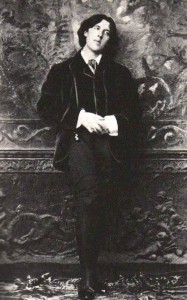Gothic Lit
The genre known as Gothic Literature or Gothic Fiction came to be known after author Horace Walpole penned the story of The Castle of Otranto (1765). To contemporary readers they found this book to be enthralling because of its’ use of suspense, the use of the supernatural, and its’ remote settings including castles and other various medieval trappings. Modern readers would find this early gothic novel laughable. (Hines, 2012) The reading is fairly dull and unexciting even though the story is fast paced. That being said, the quickness of which the story moves detracts from critical plot lines and makes any sense of suspense impossible.
There are several stereotypes that can be made for the Gothic genre. Generally they create a feeling of gloom, and mystery. Suspense is a given for any gothic novel, as are indescribable horrors of the night that gives inclinations towards the sensational. Today the gothic is easily recognized, by watching just one scene of a movie or reading several pages of a novel it will be clear to the observer whether it is a gothic tale or not.
Several novels are known for their use of the Gothic style such as:
- Charlotte Bronte: Jane Eyre (1847)
- Emily Bronte: Wuthering Heights (1847)
- Mary Shelley: Frankenstein (1818)
- Bram Stoker: Dracula (1897)
- Gaston Leroux: The Phantom of the Opera (1909)
Let’s look at a defining gothic tale The Picture of Dorian Gray and its author Oscar Wilde. Let us first begin with the man who penned the novel. Oscar Wilde was born in 1854 to intellectual Irish parents in Dublin. He studied the classics at both Oxford and Trinity College in Dublin. He gained fame as a playwright in London during the 1880’s and the early 1890’s, but today he is best known not for his successful plays, but his one and only novel, The Picture of Dorian Gray.

by James Grissom, used under CC BY-ND
The Tale: The story is set in London during the late 19th century and is focused around its’ main character Dorian Gray. The first scene is one in which an artist is finishing up his keystone piece, a portrait in which a dashing, handsome Dorian Gray is portrayed. After an extensive exchange between Dorian Gray, the artist and a wealthy man, Dorian is persuaded to pursue a life of hedonism. “The only way to get rid of a temptation is to yield to it.” (Wilde, 1890) Dorian looks at his portrait and is morose at the thought that his portrait shall stay forever young while he must age and grow ugly; resultantly he wishes that he shall stay youthful forever while his portrait bares the weight of growing old. Upon the realization that his wish has come true he begins to live riotously, indulging in every sin and vice. For each unclean act he partakes in, his portrait bares the scar. This continues until he can no longer stand to look at his portrait and becomes apologetic. Dorian then determines the only way to come clean of his past transgressions is to tear the portrait apart. He takes a knife and plunges it through the canvas. The final scene is of a body withered and aged beyond recognition, identified as Dorian Gray only by a ring on one of his fingers. Meanwhile, the portrait has returned to its’ original state, that of a young and dashing Dorian Gray.

by wildechild, used under

Critical Reception: Soon after publication British newspapers began to take a very critical stance on the story. One paper stated that it dealt in “matters only fitted for the Criminal Investigation Department” and would be of interest only to “outlawed noblemen and perverted telegraph-boys.” The story was deemed nasty and nauseous for its depiction of living only for pleasure. Another aspect that received much of the critiques was the noticeable homosexual overtones. This novel was among the first to depict homosexual desire so accurately. In 1895, when Wilde was brought to trial on charges of sodomy and gross indecency (homosexual acts) his novel was read by the opposing attorneys calling it a “sodomitical book.” (Ross, 2011) He was found guilty, likely not because of his love of young men but because of his unwillingness to back down from his position.
be felt today. Oscar Wilde was one of the first writers to tell the stories of homosexual men in high society and was shunned because of it. He was seen as a martyr for many in the gay community up through the 1970’s. In a broader sense the Gothic produced many wider and longer lasting impacts than Oscar Wilde. This style gave birth to many different genres, ranging from Science Fiction novels like The War of the Worlds, to gory thrillers like the contemporary SAW movies. The Gothic gave a voice to all that was dark and gloomy in the world, it allowed writers and their audiences to experience that which could only be achieved in their darkest dreams. Look below to see what other genres the Gothic style influenced:
Gothic Fiction Impact
Today Gothic Fiction has come a long way and influenced generations of writers and storytellers. Below is a diagram showing areas where this genre has made an impact:
- Gothic Fiction
- Crime Fiction
- Impacted Arthur Conan Doyle
- Sherlock Holmes
- Impacted Arthur Conan Doyle
- Crime Fiction
- Horror
- Horror Fiction
- R.L. Stine “Goosebumps”
- Thrillers
- Psychological
- T.V series “Dexter”
- Political
- Tom Clancy “Hunt for the Red October”
- Gory
- The SAW series
- Crime
- Stieg Larsson “The Girl with the Dragon Tattoo”
- Psychological
- Horror Fiction
- Science Fiction
- Super Hero
- Marvel, DC
- Space
- Star Wars Trilogies
- Time Travel
- H.G Wells “The Time Machine”
- Fantasy
- H.G Wells “War of the Worlds”
- Dystopian Future
- George Orwell “1985”
- Super Hero
- Gothic Romance
- Edgar Allen Poe
- The Raven
- Tim Burton
- Corpse Bride
- Nightmare Before Christmas
- Edgar Allen Poe
Works Cited
Hines, Jack. “Gothic Literature.” 15 5 2012. litgoth.org. 13 4 2014.
Ross, Alex. “Deceptive Picture.” New Yorker 8 August 2011: 1-4.
Wilde, Oscar. The Picture of Dorian Gray. London: Lippincott, 1890.